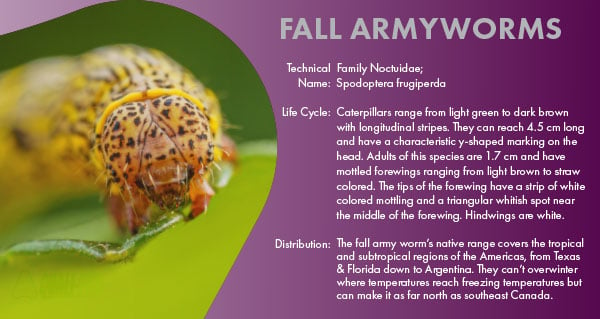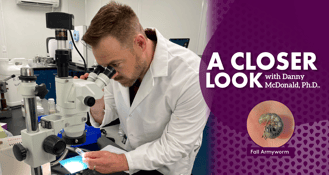“Armyworm” refers to several species of caterpillars in the family Noctuidae that can reach devastating population densities that might remind you of an “army”. Many of these species are pests is the summer. However, the Fall Armyworm (Spodoptera frugiperda), as you have probably guessed by now, is named so for being in the destructive larvae stage during fall months.

Armyworms feed on grass and many crops, making them a major pest of lawns, golf courses, sod farms, pastures, and athletic fields. They feed on a variety of grass species including bermudagrass, ryegrass, fescue, and bluegrass. Due to large populations and their voracious appetites, the damage can be extensive (think football fields), in just a few days. Although the moth stage is nocturnal, the caterpillars feed throughout the day with peak foraging in early morning and late afternoon.
Birds and wasps are major enemies of fall armyworms. In fact, birds foraging on turfgrass fields can serve as an indicator of fall armyworm infestations. Fall armyworm caterpillars have even been known to cannibalize each other when the opportunity arises.
Mild winters that fail to kill the overwintering populations often lead to breakout years the following autumn. Fall Armyworms have several generations per year, but large population densities occur in late summer through fall. In the U.S., this species can typically only survive winters in Texas and Florida. In areas where they cannot overwinter, adult moths ride northward on tropical storms and weather fronts, sometimes reaching as far north as Canada. Because these migration events are tied to weather patterns, the timing of infestations can be highly unpredictable. As a result, selecting chemical control options with long residual activity is especially important, helping turf managers take the guesswork out of application timing and ensuring consistent protection throughout the season.
Early season applications of Contrado (chlorantraniliprole), when used at rates that provide season-long control of white grubs and billbugs, also deliver extended protection against turf-feeding caterpillars such as fall armyworm. By implementing this strategy in the spring, turf managers can remove the guesswork associated with application timing that arises from the unpredictable migration and development of fall armyworm populations. In addition, Contrado offers a non-pyrethroid option with a novel mode of action, providing a safer approach for beneficial organisms while diversifying resistance management programs.
If the spring application window is missed and rescue treatments become necessary, timely scouting is critical. Monitor turf closely for early instar caterpillars, as treating populations before they reach the destructive 4th and 5th instars, when more than 90% of feeding occurs, is essential to preventing severe damage. Look for the distinctive Y-shaped marking between the eyes of caterpillars as a key diagnostic feature of fall armyworm. Treatment options include Contrado and Bifenthrin I/T. Foliar applications of Contrado, targeted specifically for caterpillars rather than systemic soil activity, can be made at 2–4 fl oz per acre, while Bifenthrin should be applied at 7.8–10.9 fl oz per acre. For best results, apply insecticides during peak foraging periods in the early morning or evening and avoid watering the treated areas for at least 24 hours post-application.
Stay connected with Quali-Pro for more turf management tips, product updates, and seasonal insights. Follow us on X and Facebook to keep your turf one step ahead of pest pressure all season long.
Technical Services Manager Turf & Ornamental - Product Development

